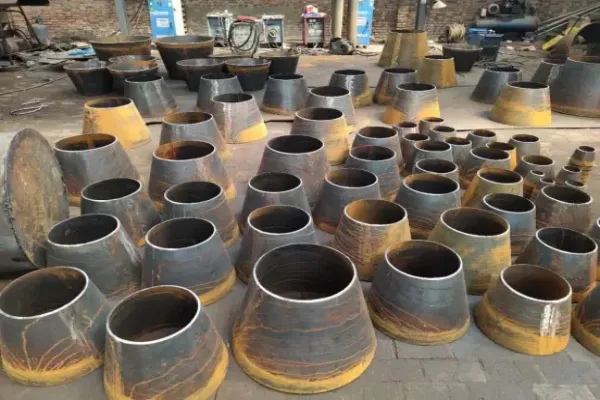Pipe reducers are essential fittings used across industrial piping systems to connect two pipes of different diameters. Whether you're working in oil & gas, chemical processing, or water treatment, understanding reducers can help optimize flow, prevent system failures, and improve pipeline efficiency.In this article, we’ll explore what pipe reducers are, the difference between concentric and eccentric reducers, their uses, manufacturing processes, and material choices—so you can select the right type for your project.
What Is a Pipe Reducer?
A pipe reducer is a type of pipe fitting used to join two pipes of different diameters. It ensures smooth fluid flow and helps maintain system pressure while adapting to various pipeline configurations.
There are two primary types of pipe reducers:
Concentric Reducer: A cone-shaped fitting that aligns the centerlines of the large and small pipes. It’s typically used in vertical pipelines, where the flow direction remains consistent and centralized.
Eccentric Reducer: Features an offset alignment where one side is flat. It is ideal for horizontal pipelines to prevent air accumulation and ensure uninterrupted flow, especially in suction lines.
Pipe Reducer Material Types
Carbon Steel Reducer vs Stainless Steel Reducer
The reducers can be made of Carbon Steel, Alloy, or Stainless steel and much more. In comparison to the Stainless Steel Reducer, Carbon Steel Reducer possesses high-pressure resistance, higher strength, and wear resistant but this can be easily corroded.
1.Carbon Steel Reducer material standards and grades:
A234 WPB, A420 WPL6, MSS-SP-75 WPHY 42, 46, 52, 56, 60, 65 and 70.
2.For Stainless Steel Reducer:
ASTM A403 WP
304, 304L, A403, 316, 316L, 317, 317L, 321, 310 and 904L, etc.
3.For Alloy Pipe Reducer:
A234 WP1, WP5, WP9, WP11, WP22, WP91 etc.

Applications of Reducers
Reducers are used across a wide range of industries. Here’s how:
1. Oil and Gas Pipelines
In upstream and downstream applications, reducers help control pressure while transferring fluids between various pipe sizes. This reduces stress on pipeline joints and enhances safety.
2. Water Treatment Facilities
Reducers are used in water transport systems to regulate flow rates between large reservoirs and narrower distribution lines, ensuring pressure consistency and efficient water delivery.
3. Chemical and Petrochemical Plants
Reducers ensure stable flow of corrosive or high-temperature fluids between processing units. Materials like stainless steel or alloy steel are often chosen for their resistance.
4. HVAC Systems
Reducers transition air ducts or coolant lines, especially when adapting to equipment with different inlet/outlet diameters like chillers, fans, and boilers.
5. Power Generation Plants
In both thermal and nuclear power plants, reducers are key in steam, water, and gas piping systems. They handle high-pressure transitions between turbine components.
Types of reducers:
1. According to its radius of curvature: it can be divided into long radius elbow
flange and short radius elbow. Long radius elbow means that its radius of curvature is equal to 1.5 times the outer diameter of the pipe, that is, R = short radius elbow means that its radius of curvature is equal to the outer diameter of the pipe, that is, R =.
2. According to the manufacturing method, it can be divided into push-making, pressing, forging, casting, etc.
3. According to the manufacturing standard, it can be divided into national standard, electrical standard, water standard, American standard, German standard, Japanese standard, Russian standard, etc.
4. According to the material, it can be divided into carbon steel, cast steel, alloy steel, stainless steel, copper, aluminum alloy, plastic, argon asphalt, etc.
Product features of reducer
Reducer is a kind of socket pipe fitting. If the selected diameter specification of the reducer does not match the inner diameter of the process pipeline, the fastener should be reduced or expanded accordingly. If the pipeline is reduced, it should be considered whether the pressure loss caused by this will affect the process flow. In order to prevent the distribution of the flow field from being affected after the installation of the reducer, resulting in pressure loss and thus reducing the measurement accuracy of the electromagnetic flowmeter, the required central cone angle α is not greater than 15°, the smaller the better. There are two types: concentric and eccentric. Concentric reducers are generally used on vertical pipes; eccentric reducers are used for horizontal pipes, and it is important to indicate whether the top is flat or the bottom is flat.
1. Not easy to deform
2. Smooth surface
3. Selected raw materials
4. Good flexibility
5. Resistant to cold and heat, pressure and corrosion.






 English
English Español
Español بالعربية
بالعربية











 Phone :
Phone :  Whatsapp :
Whatsapp :  Email :
Email : 


